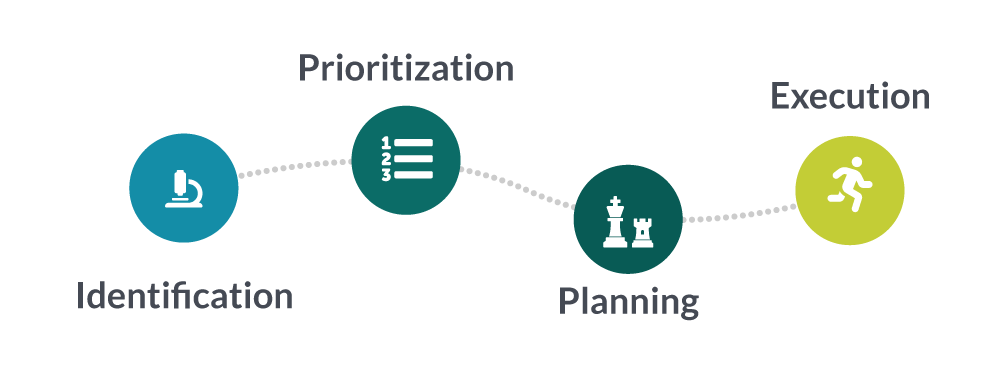Delivering quality projects within a specified time frame is important for organizations who want to stay ahead of the competition. Projects these days are becoming increasingly complex and any potential risk of failure needs to be managed using available resources that won’t compromise the product’s quality. With business critical projects, instead of finding a way to do more with less, organizations need to focus on finding ways to achieve better with less. To do this, the team should concentrate on risk-based testing aspects of the project that can reduce the possibility of failure by maintaining quality and stability. With this approach, organizations can quantify and mitigate risks, helping them to prioritize test cases more effectively. Feature, module, or functionality priorities can be identified from the perceived severity of risk and the potential impact on end-users.

Overview of Risk-Based Testing
Risk is a potential problem that could have negative consequences, or an uncertain event that may or may not occur in the system at any point in the future. There are three crucial factors involved in defining the success of a project. These are requirements, time, and budget. If the requirements are completed within the project’s time-frame and cost estimate, then the project is considered as successful. We can now categorize risk on the basis of above mentioned factors.
Requirement Risk: Requirements that are unclear and with parts missing, are poorly written, do not comply with end-user needs, or are ambiguous, and inadequate, can cause potential failure in the project.
Technical Risk: If frequently changing requirements are not handled well, a failure in the system may occur. Besides, complex architecture, non-availability of required expertise, a lack of new tools or advanced technology, inappropriate domain knowledge, etc., can create a risk.
Scheduled Risk: This occurs when the budget is exceeded, or there have been incorrect estimations, a lack of communication among team members, employing less-skilled resources, etc.
It is evident that risk is best managed with premeditated actions because we cannot anticipate the occurrence of risk ahead of time.
Why Risk Based Testing is needed?
Risk can be described as exposure to the potential of an unexpected outcome that have unfavorable consequences on the system. To neutralize risk, teams need to identify any scenarios that might impact severely, and devise a suitable testing approach to handle and negate any unwanted consequences. This is why there is a need for risk-based testing. Often, we see that projects with strict deadlines can sometimes force organizations to deliver the system before the testing cycle has been completed. Budget constraints can limit organizations to produce more with less, meaning that end-to-end testing is not possible. In these situations, risk-based testing focusing on priorities, should be adopted.
Risk Based Testing Process
The following are important steps in the RBT process:
Risk Identification: The aim is to identify and analyze the specified requirements which have a potential risk associated with them.
Risk Analysis and Prioritization: Once requirements have been filtered, they need to be prioritized on the basis of the potential severity, criticality, and complexity. A risk analyst or an experienced software engineer will be in the best position to carry out this activity.
Test Planning and Design: The objective is to define a test approach based on previous activities. An experienced test team member will be in a good position to allocate the correct resources for the right task. Also, test cases an be designed for each identified risk to cover all the aspects.
Test Execution and Monitoring: After the execution of the test cases, continuous monitoring is useful for the improvement of the risk-based testing approach in the long term.

Advantages:
By employing the RBT approach, organizations reap benefits in many ways:
- When test cases are run in an order of risk priority, then the chances are high that severe defects will be unearthed early.
- As discussed, organizations have time pressure, budget constraints and limited resources to deliver the system with negligible defects. With the RBT approach, despite all the hurdles, the team are able to focus on more important areas and devise a better strategy.
- With the RBT approach, teams are not only able to identify risk associated with the requirements or functionalities, but most importantly with the business as well.
- By using the RBT approach, teams can effectively prioritize their testing activities by just focusing on the critical areas, which will dramatically reduce the number of test cases. In this way, time is saved because testing becomes a targeted activity.
- Organizations are able to measure the risk mitigation level which helps them to make decisions on when to release the project into the production environment.
As you can see, the risk-based testing approach enable teams to move efficiently in a targeted and organized fashion when there are various constraints and hurdles.
Disadvantages:
There are several disadvantages which are as follows:
- There are situations when we might categorize a risk as being low grade, but it turns out to be a huge problem in the future.
- There are many scenarios when risk mitigation consumes more time than expected, which ultimately accelerates the cost, and delays the defect identification process..
- There are no predefined criteria for risk assessment, so we have to rely on the judgment of a risk analyst or an experienced software engineer.
- Risk identification is not an easy task, which makes it difficult to employ the right person for the job.
Conclusion:
By using risk-based testing, the test team can streamline their efforts to minimize and mitigate risk.
Although RBT does not have the parameters to guarantee a risk-free project, it can be executed with the best practices to balance the quality with risks.

